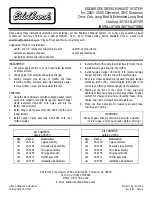
11-1
55TH0-74E
Corrosion Prevention
It is important to take good care of your
vehicle to protect it from corrosion. Listed
below are instructions for how to maintain
your vehicle to prevent corrosion. Please
read and follow these instructions carefully.
Important Information about Corro-
sion
Common causes of corrosion
1) Accumulation of road salt, dirt, moisture
or chemicals in hard-to-reach areas of
the vehicle underbody or frame.
2) Chipping, scratches and any damage to
treated or painted metal surfaces
resulting from minor accidents or abra-
sion by stones and gravel.
3) Any or all of the below mentioned
points:
• Continuous exposure to sunlight
• Hard water & sea water coming in con-
tact with vehicle.
• Foot rubbing (skirting).
Environmental conditions which accel-
erate corrosion
1) Road salt, dust control chemicals, sea
breeze or industrial pollution will all
accelerate the corrosion of metal.
2) High humidity will increase the rate of
corrosion particularly when the tem-
perature range is just above the freez-
ing point.
3) Moisture in certain areas of a vehicle
for an extended period of time may pro-
mote corrosion even when other body
sections are completely dry.
4) High temperatures will cause an accel-
erated rate of corrosion to parts of the
vehicle which are not well-ventilated to
permit quick drying.
This information illustrates the necessity of
keeping your vehicle (particularly the
underbody) as clean and dry as possible. It
is equally important to repair any damage
to the paint or protective coatings as soon
as possible.
How to Help Prevent Corrosion
Wash your vehicle frequently
The best way to preserve the finish on your
vehicle and to help avoid corrosion is to
keep it clean with frequent washing.
Wash your vehicle at least once during the
winter and once immediately after the win-
ter. Keep your vehicle, particularly the
underside, as clean and dry as possible.
If you frequently drive on salted roads,
your vehicle should be washed at least
once a month during the winter. If you live
near the ocean, your vehicle should be
washed at least once a month throughout
the year.
For washing instructions, refer to “Cleaning
Exterior” section.
Remove foreign material deposits
Foreign materials such as salts, chemicals,
road oil or tar, tree sap, bird droppings and
industrial fall-out may damage the finish of
your vehicle if it is left on painted surfaces.
Remove these types of deposits as quickly
as possible. If these deposits are difficult to
wash off, an additional cleaner may be
required. Check that any cleaner you use
is not harmful to painted surfaces and is
specifically intended for your purposes.
Follow the manufacturer’s directions when
using these special cleaners.
Repair finish damage
Carefully examine your vehicle for damage
to the painted surfaces. Should you find
any chips or scratches in the paint, touch
them up immediately to prevent corrosion
from starting. If the chips or scratches have
gone through to the bare metal, have a
qualified body shop make the repair.
Summary of Contents for NEXA BALENO
Page 1: ...11 11 11 11...
Page 8: ......
Page 16: ...55TH0 74E MEMO...
Page 32: ...1 15 QUICK GUIDE 55TH0 74E Instrument cluster Type B 55T010160 23 22 19 20 21 18 18 25 26 27...
Page 100: ...55TH0 74E...
Page 284: ...55TH0 74E...
Page 332: ...55TH0 74E...
Page 382: ...55TH0 74E...
Page 400: ...55TH0 74E...
Page 421: ......
Page 422: ......
















































